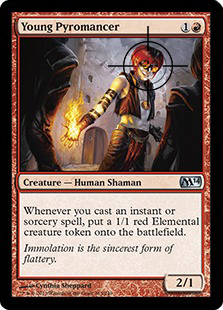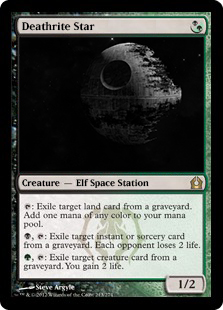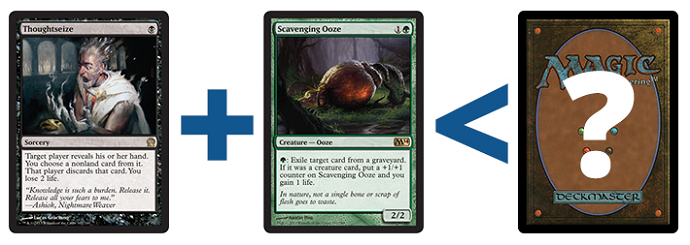Why don’t more people play Life from the Loam in Modern? Life from the Loam is some powerful Magic and historically has been a player in Standard, Extended, and Legacy. Yet it remains a tier 2 card in tier 2 decks in Modern and has for some time.
Consider the purpose of deckbuilding in Magic: The Gathering. Do you happen to know offhand what the idealized goal of any given deck should be?
Consistency.
The purpose of deckbuilding is to construct a tool that can replicate the same game states as often as possible while converting them into victories as often as possible. That’s right—every tournament is basically the plot of Groundhog Day in microcosm.

The most obvious example of this concept is Goblin Charbelcher in Legacy. It wants to Belch you on turn 1 or Empty you if it can’t Belch. There aren’t any Plan Cs; there are only late Plan As and Plan Bs. Let’s take a more nuanced example: U/W/R Flash from the recently deceased Standard format. Every game plays out the same way—you make land drops, remove threats, cast a Revelation, and assert pressure while continuing to ride the card-advantage train. The games might involve totally different cards and take anywhere from seven to 27 turns, but the basic pattern is identical. The only variations come from failures in execution or trumps like Aetherling.
Fruit of the Loam
Could any card be more perfectly suited to executing within this paradigm than a dredge spell? Life from the Loam is so powerful because in exchange for committing yourself to it, Life from the Loam will allow you to fuel redundant turns ad nauseam. It’s on you to come up with how you convert Life from the Loam’s lands into an in-game advantage, but when done successfully you’ll be trapping the opponent inside a never-ending card-advantage engine!
Or killing them outright. Whatever floats your boat . . .
As I said above, Life from the Loam has seen some minor play in Modern already. Take a look at the Gifts Loam deck that Dave "The Loam Ranger" Shiels took to eighth ninth place at Grand Prix Portland.
Creatures (10)
Planeswalkers (3)
Lands (22)
Spells (25)

Here, Life from the Loam becomes a key angle of attack installed within a Gifts Ungiven shell. It allows the Gifts player to make their land drops, attack the opponent’s hand with Raven’s Crime or Liliana of the Veil, attack their mana with Ghost Quarter / Tectonic Edge, and last but not least supplies a never-ending stream of Creeping Tar Pits with which to kill the opponent.
That’s a horrifying mental image.
This deck, on the other hand, is kind of beautiful. Left unchecked, Life from the Loam can manage every resource in a game of Magic within this shell. The rest of the deck is built to handle opposing pressure—mostly coming from permanents—while crafting an inexorable win made possible by Loam’s inevitability . . . with an honorable mention to Sunny T.
Here’s another Life from the Loam strategy popularized in recent months by Logan Nettles, better known online as Jaberwocki.
Planeswalkers (3)
Lands (27)
Spells (30)
- 2 Lightning Bolt
- 2 Pyroclasm
- 1 Mountain
- 3 Seismic Assault
- 4 Life from the Loam
- 4 Smallpox
- 2 Flame Jab
- 3 Raven's Crime
- 2 Inquisition of Kozilek
- 3 Desperate Ravings
- 4 Faithless Looting
Sideboard

Jaberwocki plays a lot of Modern (and that’s coming from me) and tends toward the Jund-colored spectrum of the format. Here, Life from the Loam defines everything. Without Gifts Ungiven to set up Unburial Rites for a fatty, you’re all in on finding a Loam to start your engine before dropping Seismic Assault and ending the opponent’s life.
This deck is very cool, and I played it a fair bit online a few months ago. Smallpox and Life from the Loam are best friends, and Smallpox is perfectly positioned for success in a world dominated by Deathrite Shaman. The most impressive synergy in the deck is the way that Faithless Looting and Desperate Ravings line up with Life from the Loam. Not only are they both very efficient at finding Loam, but each spell also improves significantly once you’ve found one, taking advantage of excess lands and turning them into spells—or, in the case of Desperate Ravings, fractions of a spell.
There’s one key theory you have to keep in mind when playing with Life from the Loam—your goal is to force the game into a battle of attrition because the player with Loam will win virtually any battle of attrition once you reach a stalemated position. The decks I’ve just posted do so in generally similar ways—one-for-one hand disruption including Liliana of the Veil and efficient creature removal. That’s a surefire recipe for stalling the game and putting the Loam player in the lead!
With that in mind, let’s examine Life from the Loam’s newest home on Magic Online.
Creatures (12)
Lands (17)
Spells (31)
- 4 Lightning Bolt
- 1 Forest
- 1 Mountain
- 1 Island
- 3 Seismic Assault
- 4 Serum Visions
- 4 Life from the Loam
- 2 Electrolyze
- 4 Flame Jab
- 4 Gitaxian Probe
- 3 Faithless Looting
Sideboard

The Down-Loam
This deck is actually pulling in a lot of directions. Let’s start by looking at our core engine in Life from the Loam. Here, Loam helps our cantrips support a very low land count while setting up Flame Jab and augmenting Faithless Looting, much as it did in Jaberwocki’s decklist above. We’ve even got the same finisher in Seismic Assault! The losses are primarily in the discard department, with no Raven’s Crime, Smallpox, or Liliana. That’s a big loss—they are your best weapons in attrition—but there are some gains.
Note that Gitaxian Probe and Serum Visions do more than just find your key spells and lands. It’s not uncommon to gain access to multiple castings of Life from the Loam in the same turn by conserving a Probe until the turn when you need it most, allowing you to quickly fill up on lands. That might seem like a minor freeroll, but after playing some games, I can attest that many opponents were very surprised to see just a few cards in hand turn into fourteen damage before they untapped!
Unlike Jaberwocki’s deck, SirStompALot’s RUG list has a creature base. I know Jaberwocki experimented with creatures in the past, including Bloodghast, but he eventually began eschewing them in order to blank opposing removal and focus on his plan. SirStompALot is instead running a pretty diverse range, with Delver of Secrets, Tarmogoyf, and Young Pyromancer.
Tarmogoyf is a good man in a dredge deck, offering a big clock that’s immune to Lightning Bolt the vast majority of the time. Most decks will have to burn Abrupt Decay to get through it or get around it, which allows Tarmogoyf to function as a bait spell for Seismic Assault. The pressure created by a fast Tarmogoyf has been instrumental in the games I’ve won with this deck against U/W/R, forcing them to Verdict or Path me after taking some damage.
Delver and Young Pyromancer are both very Boltable, with the former most often acting like a lightning rod to protect the latter. Delver is basically Secret Service in this deck, with the 3/2 Aberration closing out the game when the occasional opponent outright blanks on removal. Young Pyromancer pairs very favorably with both cantrips and retrace, making it easy to build a token horde if you ever happen to untap with Pyromancer in play. Of course, I wouldn’t know if that’s actually true because I’ve never done that in my entire life!

While individually powerful, this deck’s range of threats plays pretty awkwardly in some matchups.
Take the U/W/R matchup. Those decks are chock full of burn, and refusing to play your Delvers and Pyromancers into their removal will wind up giving them the time to fling all of the burn at your face before slamming you with Celestial Colonnade for the kill. You have to make the grudging trade with Delver most of the time, but try to get two triggers out of each Young Pyromancer—that way, you’re not just getting constantly blown out by Electrolyze. Hands that are heavy on Tarmogoyf are ideal in this matchup, and you should be clearing Snapcaster Mages on sight. Not only do they represent a not-insignificant clock, but they can team up with burn to take down Tarmogoyf or just roadblock it for a crucial handful of turns.
After playing against U/W/R a fair bit, I’ve come to the conclusion that it can’t be very favorable as configured. You’re likely to win if you land Seismic Assault, as they have very few ways to check that, but it’s difficult to resolve the enchantment if they play very carefully outside of just getting lucky.
The Jund matchup operates completely differently, even though their deck is action-packed with removal, because their cards don’t convert into your life total as directly. Leading Delver into Tarmogoyf or Young Pyromancer plus a spell is strong against Jund because their Lilianas aren’t very good against you—effectively a three-mana edict because the +1 is blank. Turns spent removing your creatures are turns not spent deploying their own, slowing the game in your favor. It’s easy to see how a Jund opponent could be caught with their pants down and suddenly die to Assault from a seemingly advantageous position . . . provided they’re not allowed to stick Deathrite Shaman or Scavenging Ooze for multiple turns.
Oh yeah, those guys exist?
Loam Sharks
In truth, Deathrite Shaman is very easy to manage. Removing one thing a turn isn’t actually enough to shut down your engine if you have a reasonable draw, as we’ve seen proven by Legacy Dredge more than a few times this year. It’s also not like you have no answers—beyond the obvious Lightning Bolt, Flame Jab alongside a land, two mana, and a moment of reflective redemption while your estranged son screams in agony will take down any Deathrite Shaman before it becomes a fully armed and operational battle station.

Scavenging Ooze, however, is a completely different story. The highest-impact addition to Modern since Deathrite Shaman himself, the Ooze has affected the viability of a wide range of archetypes . . . including those leaning on Life from the Loam. This deck exists in a peculiar space, as it’s reasonably well built to beat an Ooze—you have a healthy amount of removal and alternate ways to win on the board via Delver and Young Pyromancer. Even Flame Jab can eventually get there as long as you don’t pass priority during the Jabbing.
However, the deck isn’t configured to beat the decks that play Ooze when one is in play—you can’t successfully split your attention. Typically, Jund’s removal will take apart your squad while the Ooze eats your engine, leaving you with no way to favorably progress the game. Is this an insurmountable problem? Maybe, but I’m not inclined to believe that’s the case.
After playing with SirStompALot’s RUG list, I began wondering if the blue was even worthwhile. Outside of some mediocre sideboard options, blue only offers the fragile Delver of Secrets, the redundant Electrolyze, and Serum Visions, with Gitaxian Probe technically playable whether you play blue or not. The mana base used above is also stressful, with two Breeding Pools, an Island, and a Forest in a deck trying to cast Seismic Assault—Cascade Bluffs or Fire-Lit Thicket would have been very helpful in many of my games.
There could be something to cutting blue. Going back to black and basically incorporating Young Pyromancer into Jaberwocki’s shell—perhaps as a sideboard card—might work out, although you’ll need a truly stern removal spell to make sure that you can handle both Tarmogoyf and Scavenging Ooze. The day may have come for Deathmark to truly shine, and I recommend boarding a few copies if that’s the route you want to go.
Even then, you’ll fall apart every now and again when Jund strips your only answer and beats you to death before you find a new one—c’est la terre sauvage!
White is interesting. Stony Silence out of the board is a major thrashing against Tron and has added value in disrupting Relic of Progenitus, the most heavily played sideboard weapon against Life from the Loam. You can even access Ray of Revelation to give you additional outs against Rest in Peace, the other major graveyard hate card! As for helping the Jund matchup . . . there, the white is less useful. Lingering Souls used to be an excellent weapon against Jund, but the popularity of Scavenging Ooze and Chandra, Pyromaster limits its effectiveness. Path to Exile answers all of your problems at a steep cost, while Theros has delivered the more vulnerable Chained to the Rocks.
It’s totally possible that you can afford to just bite the bullet and Path everything given the advantage Loam grants you going long, but it’s a dangerous route considering the weapons Jund has access to, including topdecking more Oozes!
Just going straight Gruul has its benefits, including a less painful mana base. All of the cards I actively want to play are red and green, so it’s possible that’s the place to start and finish! Here’s a basic outline:
3-4 Lightning Bolt (necessary due to Ooze and Shaman)
4 Faithless Looting
3-4 Flame Jab
4 Life from the Loam
3 Seismic Assault
? Young Pyromancer
? Tarmogoyf
1-3 Raging Ravine / Treetop Village
1 Fire-Lit Thicket
1 Forest
7-10 fetch lands
1-2 Stomping Ground
I’m having a lot of fun playing with these ideas, and there could very well be a legitimate deck here somewhere. I haven’t found a great way to beat Thoughtseize into Scavenging Ooze yet; maybe some of you guys will have better luck solving that puzzle.

You’re welcome to post any ideas in the comments or ship them to me on Twitter!
Friends in Loam Places
For those of you who like the deep end of the pool . . .
- Does Pyromancer’s Swath even have a drawback in that shell? Making every Flame Jab into a Lightning Bolt is pretty awesome, and once you hit five mana with a Swath in play, you’ll never need a draw step again—that’s nine damage a turn until they’re dead thanks to Loam. You’ll be vulnerable following its casting to both Abrupt Decay and fresh Scavenging Oozes, but that might just mean that you’re accepting the risk or using it as additional Seismic Assaults against control decks.
- Pyromancer Ascension functions along the same lines, turning Flame Jab into Fire but also improving all of your other spells significantly. Yes, it’s "another way to get crushed by Abrupt Decay and Scavenging Ooze," but it’s also a great weapon against control. I could see sideboarding these for those matchups, as sliding one under Mana Leak and Cryptic Command is very easy.
- You don’t have to play black to play Bloodghast, although it certainly helps. That’s another way to attack the control matchups, as keeping a threat on the table will force them to expend mana and in turn give you room to cast your Seismic Assaults and Loams. This little guy is probably a bit too slow for the big time, but it means well.
- Our own Deathrite Shamans don’t synergize with Life from the Loam, but they do enable faster Seismic Assaults and can be a relevant threat against U/W/R as well assuming access to black mana.
- Transformational sideboards could be the best way to sidestep the hate, though it seems unlikely that we could transform into anything that can consistently beat Jund in fifteen cards. Many decks in the format can’t do that with the full 75!
I’m sorry I haven’t been streaming lately—I’m making a mad dash for Qualifier Points during one of the busiest weeks of the year at StarCityGames.com, which means I’m trying to play as many queues as possible during the few hours I have to play. Both my ability to entertain and to cast spells competently deteriorate as I add games, but once this MOCS season is over and I get some free time, I’m looking forward to hopping back on the horse. In the meantime, feel free to send me any sweet Modern decks you see!
Glenn Jones
@SecludedGlenn
My Twitch Stream
